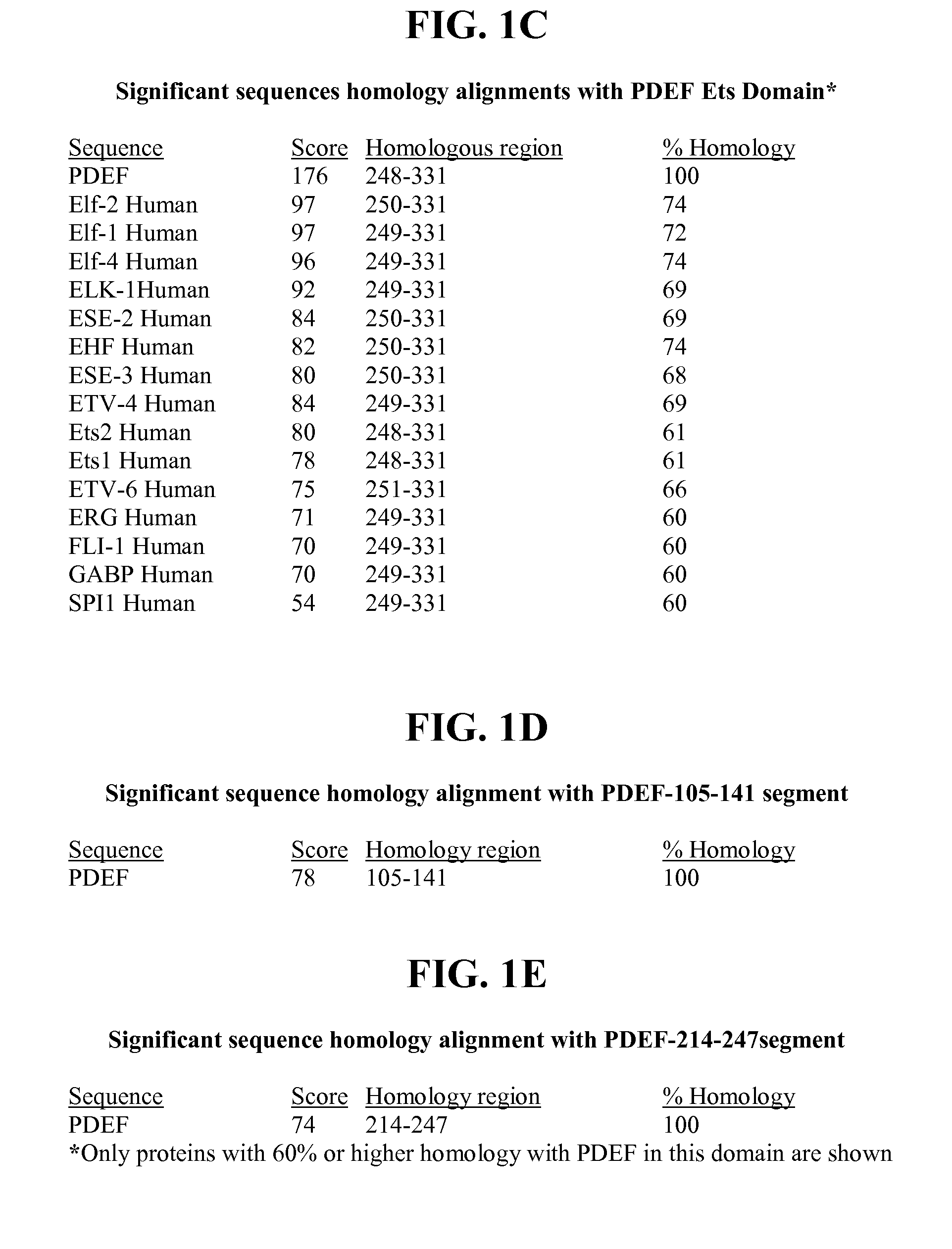Anti-pdef antibodies and uses thereof
a technology of pdef and antibodies, applied in the field of isolated antibodies or antigen-binding fragments, can solve the problems of only 10-20% survival rate in 5 years, limited knowledge in the art about the characteristics of pdef expression in human cancer, and all work performed
- Summary
- Abstract
- Description
- Claims
- Application Information
AI Technical Summary
Benefits of technology
Problems solved by technology
Method used
Image
Examples
example 1
Antibody Production: Anti-PDEF Antibody
[0167]A Blast homology search for PDEF protein sequence showed significant homology (60-74% amino acid residue homology, as shown in FIG. 1C) with the C-terminal DNA binding Ets domain of PDEF with that of other Ets factors. Also, there is significant homology in the Pointed domain of PDEF with other human Ets factor proteins (shown in FIG. 1B). In contrast, the N-terminal segment of PDEF comprising residues 1 to 104 (PDEF-1-104) revealed homology only to PDEF (shown in FIG. 1A). Therefore, this PDEF-1-104 segment was selected for producing polyclonal antibodies in rabbits. Briefly, the cDNA encoding the N-terminal 1 to 104 amino acids was PCR-amplified and subcloned into the bacterial expression vector pET15b (Novagen, Madison, Wis.) at the Nde I site. After confirmation of the orientation and sequence, E. coli BL21 (DE3) cells were transformed by the resultant pET15b-PDEF-1-104 plasmid. The cells were induced by 1 mM IPTG and PDEF protein was...
example 2
Specificity of Anti-PDEF Antibody by Western Blotting and Immunohistochemistry
[0168]As shown in Panel A of FIG. 2, anti-PDEF antibody reacted specifically with a 46 kD band in the MCF-7 breast tumor cell line, but not with the SKBR3 breast tumor cell line or the non-breast tumor cell lines Hela and U937. Also, the antibody reacted strongly with recombinant PDEF protein run as control. Further, the antibody showed specific nuclear staining of tumor cells in the MCF-7 breast tumor cell line (FIG. 2, panel B), and its prior incubation with PDEF 1-104 peptide eliminated the staining. Furthermore, screening of the tissue sections from a primary breast carcinoma (FIG. 2, Panel C) and a primary prostate carcinoma (FIG. 2, Panel D) showed specific staining of the epithelial tumor cells, a result consistent with epithelial cell specific expression of PDEF mRNA.
example 3
Transfection of PDEF-Lacking MCF12-A Cell Line with PDEF Induces Reactivity with Antibody
[0169]Specificity of the anti-1-104 antibody for PDEF was further tested by transfecting PDEF-lacking MCF-12A cell line with PDEF expression plasmid. As shown in FIG. 3, only the PDEF-transfected MCF-12A cells but not vector-transfected MCF-12A cells showed reactivity with our antibody.
PUM
| Property | Measurement | Unit |
|---|---|---|
| affinity | aaaaa | aaaaa |
| PSA | aaaaa | aaaaa |
| length | aaaaa | aaaaa |
Abstract
Description
Claims
Application Information
 Login to View More
Login to View More - R&D
- Intellectual Property
- Life Sciences
- Materials
- Tech Scout
- Unparalleled Data Quality
- Higher Quality Content
- 60% Fewer Hallucinations
Browse by: Latest US Patents, China's latest patents, Technical Efficacy Thesaurus, Application Domain, Technology Topic, Popular Technical Reports.
© 2025 PatSnap. All rights reserved.Legal|Privacy policy|Modern Slavery Act Transparency Statement|Sitemap|About US| Contact US: help@patsnap.com



